Dr. Mack Thetford
 Associate Professor of Environmental Horticulture
Associate Professor of Environmental Horticulture
University of Florida, West Florida Research and Education Center, Milton, Florida
Japanese Silver Grass, Miscanthus sinensis, is a perennial, clump-forming, warm-season, deciduous grass that has been a popular garden plant for centuries. The common name of Silver Grass is actually a good descriptor for the foliage of this species. The midrib of the leaf blade has a silver stripe on the upper surface that runs the entire length of the leaf blade. Many cultivars have been selected with various patterns of variegation or leaf color, some without the characteristic silver stripe of the species. The leaves grow upward and curve outward while the flowers appear in late summer to fall, towering above the cascades of foliage. Depending on the cultivar, height will range from 3 to 12 feet with a spread of 3 feet or more. The diversity of cultivars within this species should allow you to select a cultivar to meet the size, color and flowering characteristics for your garden needs.
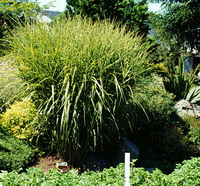 Miscanthus sinensis 'Zebrinus', Zebra Grass is a large, upright selection of silver grass. The plant (foliage and flowers collectively) will reach 5 to 6 feet tall and may achieve an equal width. Leaves are from 1½ to 2½ feet in length and have striking horizontal bands of creamy yellow variegation. Copper-pink flowers appear in late summer (August to September) and extend 1 to 2 feet above the foliage. Foliage and flower stalks are very persistent and provide continued beauty and movement during winter months. Plant in a full sun location.
Miscanthus sinensis 'Zebrinus', Zebra Grass is a large, upright selection of silver grass. The plant (foliage and flowers collectively) will reach 5 to 6 feet tall and may achieve an equal width. Leaves are from 1½ to 2½ feet in length and have striking horizontal bands of creamy yellow variegation. Copper-pink flowers appear in late summer (August to September) and extend 1 to 2 feet above the foliage. Foliage and flower stalks are very persistent and provide continued beauty and movement during winter months. Plant in a full sun location.
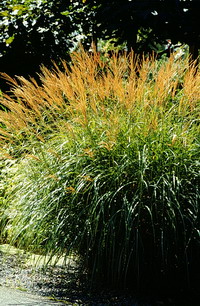 Miscanthus sinensis 'Arabesque', Arabesque Silver Grass is a large, upright, compact selection of silver grass with leaves from 1 to 2 feet in length. The plant (foliage and flowers) will reach 3 to 5 feet tall and may achieve an equal width. Golden brown flowers appear in late summer (August to September) and extend 1 to 1½ feet above the foliage. Flowers fade to a clear silvery white and the persistent flower stalks provide continued beauty and movement during winter months. Plant in a full sun location.
Miscanthus sinensis 'Arabesque', Arabesque Silver Grass is a large, upright, compact selection of silver grass with leaves from 1 to 2 feet in length. The plant (foliage and flowers) will reach 3 to 5 feet tall and may achieve an equal width. Golden brown flowers appear in late summer (August to September) and extend 1 to 1½ feet above the foliage. Flowers fade to a clear silvery white and the persistent flower stalks provide continued beauty and movement during winter months. Plant in a full sun location.
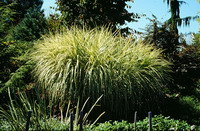 Miscanthus sinensis 'Variegata', Variegated Japanese Silver Grass is one of the oldest cultivars of silver grass and has been popular in gardens since the early 1900's. This is an upright, arching selection of silver grass forming an open, loose clump. Leaves are from 1½ to 2½ feet in length and have vertical bands of creamy white variegation. The plant (foliage and flowers) will reach 4 to 6 feet tall and may achieve an equal width. Golden brown flowers appear in late summer (August to September) and extend 1 to 2 feet above the foliage. Foliage and flower stalks are very persistent and provide continued beauty and movement during winter months. Plant in a full sun to partially shaded location.
Miscanthus sinensis 'Variegata', Variegated Japanese Silver Grass is one of the oldest cultivars of silver grass and has been popular in gardens since the early 1900's. This is an upright, arching selection of silver grass forming an open, loose clump. Leaves are from 1½ to 2½ feet in length and have vertical bands of creamy white variegation. The plant (foliage and flowers) will reach 4 to 6 feet tall and may achieve an equal width. Golden brown flowers appear in late summer (August to September) and extend 1 to 2 feet above the foliage. Foliage and flower stalks are very persistent and provide continued beauty and movement during winter months. Plant in a full sun to partially shaded location.
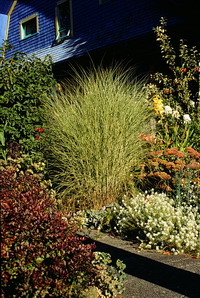 Miscanthus sinensis 'Morning Light', Morning Light Silver Grass is an introduction by the U.S. National Arboretum in Washington, D.C. This plant has a fine texture in comparison to most silver grass cultivars. The arching leaves are narrow, ranging from 1/4 to ½ inch in width, 1 to 2 feet in length and along with the flowers, creates a compact, upright clump 4 to 5 feet tall. The center of each leaf is dominated by a bright silver streak while the leaf margins are bordered by a clear, narrow, white stripe. Reddish bronze flowers appear in late summer (September to October) on stalks extending 1 to 2 feet above the foliage and the seedheads dry to a creamy white. Miscanthus sinensis Gracillimus is cultivar with a form and texture similar to Morning Light but with no white stripe. Plant in a full sun location.
Miscanthus sinensis 'Morning Light', Morning Light Silver Grass is an introduction by the U.S. National Arboretum in Washington, D.C. This plant has a fine texture in comparison to most silver grass cultivars. The arching leaves are narrow, ranging from 1/4 to ½ inch in width, 1 to 2 feet in length and along with the flowers, creates a compact, upright clump 4 to 5 feet tall. The center of each leaf is dominated by a bright silver streak while the leaf margins are bordered by a clear, narrow, white stripe. Reddish bronze flowers appear in late summer (September to October) on stalks extending 1 to 2 feet above the foliage and the seedheads dry to a creamy white. Miscanthus sinensis Gracillimus is cultivar with a form and texture similar to Morning Light but with no white stripe. Plant in a full sun location.
Fountain Grass, Pennisetum alopecuroides, is a perennial, clump-forming, warm-season, deciduous grass that has also been a popular garden plant for many years. The common name of Fountain Grass is reminiscent of the overall shape and form of the cascading clumps of foliage and flowers. The narrow leaves grow upward and curve outward and the white flowers appear in early summer to fall, towering above the cascades of foliage. The species with its variable leaf size and form and varied flower color, may reseed itself and move around the garden. For this reason, it is suggested to select cultivars that are grown from divisions to ensure uniform plantings of plants that will not reseed throughout the garden. An interesting variety of Fountain Grass is Pennisetum alopecuroides viridescens, Black Seeded Fountain Grass. This variety has very dark flowers and seedheads and two popular cultivars called Moudry and National Arboretum, although striking in appearance, may prove to be somewhat invasive if the ripe seedheads are not removed after flowering.
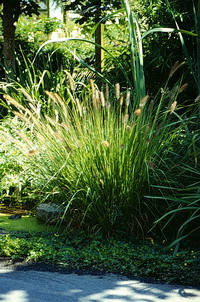
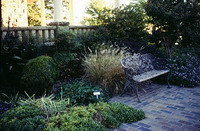 Pennisetum alopecuroides 'Hameln', Hameln Fountain Grass is a warm-season, deciduous, perennial fountain grass with dark green foliage and whitish flowers. The leaves are slightly curved, 1/8 to 1/4 inch in width, and 1 to 1½ feet in length. Plants (foliage and flowers) form an upright, mounding clump reaching a size of 2 to 3 feet tall. The inflorescence is 1 to 2 inches wide and 3 to 4 inches long, appear white to creamy tan and are held above the foliage. Flowers begin to appear in July and continue through August. Unlike the species with its variable leaf size and form and varied flower color, the cultivar Hameln does not reseed itself and will provide a planting with a uniform appearance. Plant in a full sun location.
Pennisetum alopecuroides 'Hameln', Hameln Fountain Grass is a warm-season, deciduous, perennial fountain grass with dark green foliage and whitish flowers. The leaves are slightly curved, 1/8 to 1/4 inch in width, and 1 to 1½ feet in length. Plants (foliage and flowers) form an upright, mounding clump reaching a size of 2 to 3 feet tall. The inflorescence is 1 to 2 inches wide and 3 to 4 inches long, appear white to creamy tan and are held above the foliage. Flowers begin to appear in July and continue through August. Unlike the species with its variable leaf size and form and varied flower color, the cultivar Hameln does not reseed itself and will provide a planting with a uniform appearance. Plant in a full sun location.
Pennisetum setaceum, Tender Fountain Grass, is a tender, perennial, clump-forming, warm-season, deciduous grass that has also been a popular garden plant for many years. The form is similar to Fountain Grass with cascading clumps of foliage and flowers. The narrow leaves grow upward and curve outward and the flowers, which appear in early summer to fall, are rose-pink. This species is listed as a noxious weed in California, will reseed and move around the garden, and will become a weed in warmer areas where it remains perennial. For this reason, it is suggested to select only cultivars of Pennisetum setaceum Rubrum, Purple Fountain Grass. Although Purple Fountain Grass does not normally set viable seed, an occasional green seedling may occur on a rare basis and should be removed. The following cultivars are grown from divisions to ensure this species will not reseed throughout the garden and neighboring woodlands.
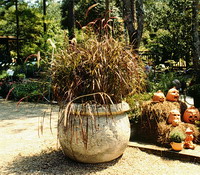 Pennisetum setaceum 'Rubrum', Purple Fountain Grass is a tender, perennial, warm season, clump-forming grass commonly used as an annual. The 3 to 4 foot plants have an upright, arching form with glossy leaves that are 1/4 to ½ inch wide and 8 to 12 inches long. Leaves are reddish purple and the plant is topped with red-purple plumes of flowers which begin to emerge in late June to early July and continue in the Gulf Coast region until frost. The inflorescence can be from 1 to 2 inches in diameter and up to 6 or 8 inches long occurring on arching stems that hold them 1 to 2 feet above the foliage. Plant in a full sun location. This plant is an excellent accent for any garden and will also tolerate the seacoast conditions of coastal gardens.
Pennisetum setaceum 'Rubrum', Purple Fountain Grass is a tender, perennial, warm season, clump-forming grass commonly used as an annual. The 3 to 4 foot plants have an upright, arching form with glossy leaves that are 1/4 to ½ inch wide and 8 to 12 inches long. Leaves are reddish purple and the plant is topped with red-purple plumes of flowers which begin to emerge in late June to early July and continue in the Gulf Coast region until frost. The inflorescence can be from 1 to 2 inches in diameter and up to 6 or 8 inches long occurring on arching stems that hold them 1 to 2 feet above the foliage. Plant in a full sun location. This plant is an excellent accent for any garden and will also tolerate the seacoast conditions of coastal gardens.
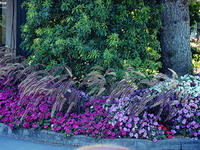 Pennisetum setaceum 'Rubrum Dwarf', Dwarf Purple Fountain Grass is a dwarf cultivar that is nearly identical to Purple Fountain Grass, only smaller. Dwarf Purple Fountain Grass is also a tender, perennial, warm season, clump-forming grass commonly used as a summer annual and will grow only 1½ to 2½ feet tall and wide with the same foliage and flowering characteristics. The compact size is the only distinguishing characteristic. This is an excellent selection for southern gardeners as this plant does not set viable seed and should not move around the garden or become naturalized.
Pennisetum setaceum 'Rubrum Dwarf', Dwarf Purple Fountain Grass is a dwarf cultivar that is nearly identical to Purple Fountain Grass, only smaller. Dwarf Purple Fountain Grass is also a tender, perennial, warm season, clump-forming grass commonly used as a summer annual and will grow only 1½ to 2½ feet tall and wide with the same foliage and flowering characteristics. The compact size is the only distinguishing characteristic. This is an excellent selection for southern gardeners as this plant does not set viable seed and should not move around the garden or become naturalized.
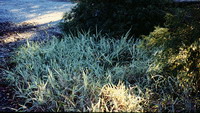
 Phalaris arundinaceae 'Feeseys Form', Feeseys Form Ribbon Grass is also known as Strawberries and Cream Ribbon Grass. Many cultivars of ribbon grass are available with creamy white variegation but this selection is prized for the blush of pink that is present on the young growth during cooler times of the year. Ribbon grass is a perennial, creeping, spreading, warm-season, deciduous grass with leaves 3/4 to 1½ inches wide and stems that reach a height of 1½ to 2½ feet tall. Flowers are soft, white terminal panicles that appear in June and will reach1 to 1½ feet above the foliage. While this grass does grow in full sun the foliage may burn. Ribbon grass will perform better in a partial shade and moist to wet location.
Phalaris arundinaceae 'Feeseys Form', Feeseys Form Ribbon Grass is also known as Strawberries and Cream Ribbon Grass. Many cultivars of ribbon grass are available with creamy white variegation but this selection is prized for the blush of pink that is present on the young growth during cooler times of the year. Ribbon grass is a perennial, creeping, spreading, warm-season, deciduous grass with leaves 3/4 to 1½ inches wide and stems that reach a height of 1½ to 2½ feet tall. Flowers are soft, white terminal panicles that appear in June and will reach1 to 1½ feet above the foliage. While this grass does grow in full sun the foliage may burn. Ribbon grass will perform better in a partial shade and moist to wet location.
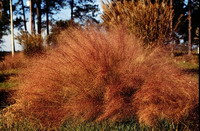 Muhlenbergia capillaris, Hairy Awn Muhly is probably one of the most stunning grasses native to the southeastern United States. This is a perennial, warm-season, clump-forming, deciduous grass. Leaves are a blue-green to gray-green, very narrow and almost wire-like. The leaves can be from 2 to 3 feet long and the arching character of the leaves creates a plant of mounded form. The most striking characteristic of this plant is the abundance of flowers that appear from October to November. Stalks of pink-purple flowers occur 2 to 3 feet above the foliage and in such profusion as to completely obscure the foliage. The flowers later fade to a crisp tan and are persistent through the winter. This grass is extremely drought tolerant and grows best in full sun.
Muhlenbergia capillaris, Hairy Awn Muhly is probably one of the most stunning grasses native to the southeastern United States. This is a perennial, warm-season, clump-forming, deciduous grass. Leaves are a blue-green to gray-green, very narrow and almost wire-like. The leaves can be from 2 to 3 feet long and the arching character of the leaves creates a plant of mounded form. The most striking characteristic of this plant is the abundance of flowers that appear from October to November. Stalks of pink-purple flowers occur 2 to 3 feet above the foliage and in such profusion as to completely obscure the foliage. The flowers later fade to a crisp tan and are persistent through the winter. This grass is extremely drought tolerant and grows best in full sun.
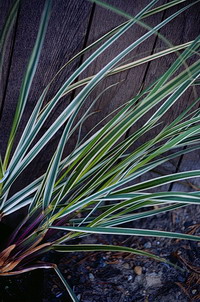 Cortaderia selloana 'Silver Comet', Silver Comet Pampas Grass is a relatively new selection of pampas grass that can be distinguished by the single white bands of variegation extending along the margins of the leaves. Pampas grass is probably one of the most popular species of ornamental grasses. The species is a perennial, warm-season, evergreen grass which forms dense clumps of foliage, and the leaves have sharp razor-like edges. Leaves are from ½ to 1 inch in width and can range from 1 to 4 feet in length. Plants (foliage and flowers) achieve a height of 4 to 6 feet with similar width. Flowers occur in August with large panicles 6 to 8 inches wide by up to 2 feet long and persist throughout the winter months. The variegated forms of Pampas grass grow slower than the species and the foliage color makes an excellent accent even without the flowers. Plant in a full sun location.
Cortaderia selloana 'Silver Comet', Silver Comet Pampas Grass is a relatively new selection of pampas grass that can be distinguished by the single white bands of variegation extending along the margins of the leaves. Pampas grass is probably one of the most popular species of ornamental grasses. The species is a perennial, warm-season, evergreen grass which forms dense clumps of foliage, and the leaves have sharp razor-like edges. Leaves are from ½ to 1 inch in width and can range from 1 to 4 feet in length. Plants (foliage and flowers) achieve a height of 4 to 6 feet with similar width. Flowers occur in August with large panicles 6 to 8 inches wide by up to 2 feet long and persist throughout the winter months. The variegated forms of Pampas grass grow slower than the species and the foliage color makes an excellent accent even without the flowers. Plant in a full sun location.
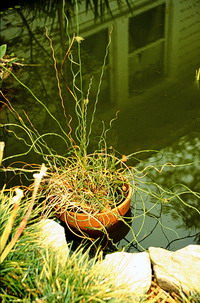 Juncus effusus 'Spiralis', Corkscrew Rush is an unusual perennial, grass-like plant for use in wet, boggy areas or garden pools or ponds. Corkscrew Rush is easily distinguished because of its unusual semi-evergreen foliage. The cylindrical, twisted leaves appear to coil like a spring originating from a tight clump and the plant can achieve a height and width of 1 to 1½ feet. Although Corkscrew Rush does flower, it is not grown for this characteristic as the flowers occur in very small cymes located near the end of the leaves and are not very showy. This plant will not tolerate dry periods and should be grown in wet areas, shallow water, or in pots at the edge of your water garden to provide a constant source of moisture. Plant in a full sun to partial shade location.
Juncus effusus 'Spiralis', Corkscrew Rush is an unusual perennial, grass-like plant for use in wet, boggy areas or garden pools or ponds. Corkscrew Rush is easily distinguished because of its unusual semi-evergreen foliage. The cylindrical, twisted leaves appear to coil like a spring originating from a tight clump and the plant can achieve a height and width of 1 to 1½ feet. Although Corkscrew Rush does flower, it is not grown for this characteristic as the flowers occur in very small cymes located near the end of the leaves and are not very showy. This plant will not tolerate dry periods and should be grown in wet areas, shallow water, or in pots at the edge of your water garden to provide a constant source of moisture. Plant in a full sun to partial shade location.
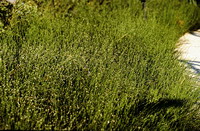 Equisetum scirpoides, Dwarf Horsetail is a perennial, creeping, spreading, grass-like plant that makes an excellent groundcover in moist, boggy areas. This plant is a miniature form of the scouring rush and resembles this plant in many ways. The evergreen foliage is dark green, jointed, segmented, and contains high quantities of silica which makes them very rough to the touch. The leaves are 1/16 inch in diameter and can reach a height of 6 to 8 inches. Consider containing this plant when used in small gardens as most horsetails can be too vigorous for small home gardens.
Equisetum scirpoides, Dwarf Horsetail is a perennial, creeping, spreading, grass-like plant that makes an excellent groundcover in moist, boggy areas. This plant is a miniature form of the scouring rush and resembles this plant in many ways. The evergreen foliage is dark green, jointed, segmented, and contains high quantities of silica which makes them very rough to the touch. The leaves are 1/16 inch in diameter and can reach a height of 6 to 8 inches. Consider containing this plant when used in small gardens as most horsetails can be too vigorous for small home gardens.
All pictures taken and owned by Dr. Mack Thetford.